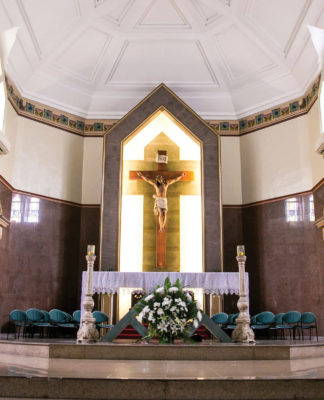 THE WORD emanates from the House of God. And the University, realizing its greater role in spreading God’s word, is now girding for a new mission: to protect Church heritage.
THE WORD emanates from the House of God. And the University, realizing its greater role in spreading God’s word, is now girding for a new mission: to protect Church heritage.
The Catholic Bishops’ Conference of the Philippines (CBCP) has tapped the UST Center for Conservation of Cultural Property and Environment in the Tropics (CCPET) to be its partner in drafting a set of guidelines that would help preserve the Church’s cultural heritage as defined by its structures, relics, and rituals, following a meeting last September.
“The center would serve as the leveling bridge between the Catholic Church and the government so that both would be able to address the threats facing the Church’s heritage,” CCPET director Erick Zerrudo said.
Because it is the only institution with a cultural-conservation arm, UST was chosen by the CBCP to be its secretariat for the joint project.
The center plans to hold annual briefings for bishops and government officials and release a primer that would answer basic questions about Church heritage.
Zerrudo said that the CBCP and CCPET endeavor is the first step toward arresting the “threats” besetting the Church’s heritage, such as social apathy and burglaries, among others.
“Preserving the Church’s historical fabric and its glorious past is an outright challenge,” Zerrudo said. “The awareness and appreciation among the people should be raised to a higher level if we want to protect the heritage.”
The two-day gathering, attended by bishops, the CBCP Permanent Committee for Cultural Heritage of the Church, the National Commission for Culture of the Arts (NCAA), the National Museum, and the National Historical Institute, was brought about by a recent agreement between the Holy See and the Philippine government on protecting Church property.
The three-page agreement signed last February contains seven articles on how the government and the Vatican can best protect the cultural heritage of the Catholic Church. Article 2 and 3, for example, tackles the proper use of both “movable and immovable cultural heritage of artistic and historic significance, comprising the colonial churches declared as legally protected by the Republic.”
Four Baroque-style churches in the country have been put under the World Heritage List of United Nations Educational and Scientific and Cultural Organization, namely the Church of San Agustin in Manila, the Church of La Nuestra Señora de la Asuncion in Ilocos Sur, Paoay Church in Ilocos Norte, and the Church of Santo Tomas de Villanueva in Iloilo City.
The NCAA website said the restoration of 26 centuries-old churches identified as “national cultural treasures” for their cultural significance and distinctive architecture has begun.
The 26 churches include the Agustinian church of Santa Monica (Capiz), San Guillermo Ermitaño and La Nuestra Señora de la Asuncion (Ilocos Sur), Santa Catalina de Alejandria (in Abra and La Union), the Cathedral of San Jose in Romblon, La Inmaculada Conception (in Batangas, Manila, and Misamis Oriental), San Andres (Zambales), San Agustin (Ilocos Norte), San Isidro Labrador (Siquijor), La Nuestra Señora de la Asuncion (Cavite), San Gregorio Magno (Laguna), San Matias (Isabela), San Juan Bautista (Albay), Patrocinio de Santa Maria (Cebu), San Vicente Ferrer (Nueva Vizcaya), Santo Tomas de Villanueva (Iloilo City), Santiago Apostol (Pampanga), San Pedro y San Pablo (Pangasinan), San IIdelfonso (Rizal), San Carlos Borromeo (Batanes), Basilica of San Miguel Arcangel (Quezon Province), and San Agustin de Hippo (Negros Oriental).
“These churches would immediately qualify for government support,” Zerrudo said. “Still, we have to make the people aware of their value and transform this awareness into a level of appreciation then protection.”
















